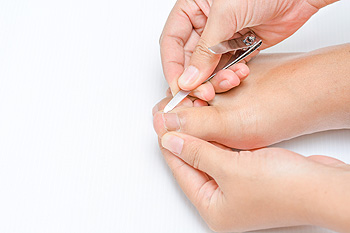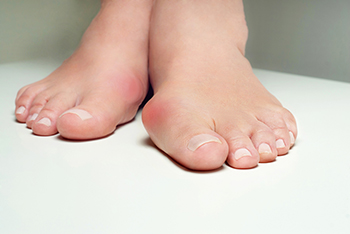Items filtered by date: February 2023
What Is Ledderhose Disease?

Hard lumps that form on the soles of the feet may be indicative of Ledderhose disease. Ledderhose disease is considered to be a rare foot condition that affects the plantar fascia. The plantar fascia is the band of tissue connecting the heels to the toes and may cause pain while walking. The lumps that form are generally benign and typically affect people middle-aged and older. The ankle joints may be uncomfortable, and a tingling sensation may be felt. The exact reason this foot condition develops is unknown, however, people with certain medical ailments may be prone to Ledderhose disease. These can include diabetic patients, people who consume excess alcohol, and those who take specific medications. Wearing custom-made orthotics may help to relieve pressure on the bottom of the feet. If you have pain in the sole of your foot, it is suggested that you consult with a podiatrist who can diagnose Ledderhose disease and offer the correct treatment options.
Some foot conditions may require additional professional care. If you have any concerns, contact Paul A. Santangelo, DPM of Illinois. Our doctor can provide the care you need to keep you pain-free and on your feet.
Rare Foot Conditions
The majority of foot conditions are common and can be treated by a podiatrist. Standard diagnostic procedures are generally used to identify specific conditions and treatment can be rendered. A podiatrist also treats rare foot conditions which can be difficult to diagnose and may need extra attention and care.
There are many rare foot conditions that can affect children. Some of these can include:
- Freiberg’s disease
- Kohler’s disease
- Maffucci syndrome
Freiberg’s disease - This can be seen as a deterioration and flattening of a metatarsal bone that exists in the ball of the foot. It typically affects pre-teen and teenage girls, but can affect anyone at any age. Symptoms that can accompany this can be swelling, stiffness, and the patient may limp.
Kohler’s disease - This often targets the bone in the arch of the foot and affects younger boys. It can lead to an interruption of the blood supply which ultimately can lead to bone deterioration. The patient may limp or experience tenderness, swelling, and redness.
Maffucci syndrome - This affects the long bones in a child’s foot leading to the development of abnormal bone lesions. They are benign growths and typically develop in early childhood and the bones may be susceptible to breaking.
A podiatrist can properly diagnose and treat all types of rare foot conditions. If your child is affected by any of these symptoms or conditions, please don’t hesitate to call our office so the correct treatment method can begin.
If you have any questions please feel free to contact our offices located in Niles and Rockford, IL . We offer the newest diagnostic tools and technology to treat your foot and ankle needs.
How Beneficial Is Stretching the Feet?

Many patients can find mild relief when stretches are performed for specific foot conditions. Stretches that may ease the pain of plantar fasciitis are often successful in temporarily reducing discomfort, and completing daily tasks may become easier. Calf raises can strengthen the tendons in the calf muscles and heels, which can ultimately make the arch stronger. This is done by standing on a step and lowering the heels one at a time until a gentle stretch is felt. A stretch that is known as doming can control the arch, which may help to prevent excess pronation. This is accomplished by pressing the toes down while standing, and keeping the heel firmly planted on the ground. The foot will form an arch, and this is an effective stretch when repeated several times. Towel curls are a popular stretch that can strengthen the entire foot. This is done by laying a towel on the floor, and picking it up by using only the toes. There are several stretches that can be done for various parts of the foot. If you would like more information about stretching the feet, it is suggested that you consult with a podiatrist.
Stretching the feet is a great way to prevent injuries. If you have any concerns with your feet consult with Paul A. Santangelo, DPM from Illinois. Our doctor will assess your condition and provide you with quality foot and ankle treatment.
Stretching the Feet
Being the backbone of the body, the feet carry your entire weight and can easily become overexerted, causing cramps and pain. As with any body part, stretching your feet can serve many benefits. From increasing flexibility to even providing some pain relief, be sure to give your feet a stretch from time to time. This is especially important for athletes or anyone performing aerobic exercises, but anyone experiencing foot pain or is on their feet constantly should also engage in this practice.
Great ways to stretch your feet:
- Crossing one leg over the others and carefully pull your toes back. Do 10-20 repetitions and repeat the process for each foot
- Face a wall with your arms out and hands flat against the wall. Step back with one foot and keep it flat on the floor while moving the other leg forward. Lean towards the wall until you feel a stretch. Hold for 30 seconds and perform 10 repetitions for each foot
- Be sure not to overextend or push your limbs too hard or you could risk pulling or straining your muscle
Individuals who tend to their feet by regular stretching every day should be able to minimize foot pain and prevent new problems from arising.
If you have any questions, please feel free to contact our offices located in Niles and Rockford, IL . We offer the newest diagnostic and treatment technologies for all your foot care needs.
Soaking and Ingrown Toenails

An ingrown toenail is a relatively common condition of the foot in which the side of a toenail essentially grows awkwardly into the skin surrounding the nail. This can cause great irritation and inflammation. Patients who seek help from a podiatrist for relief are in the best hands because this type of doctor can treat the condition. It can also be recommend the patient develop certain habits at home to facilitate the healing process. For example, depending on the specific case, it may be suggested by the podiatrist that you begin soaking the feet. This may be done in any number of ways. Specifically, the podiatrist may advise that you soak your feet in warm, soapy water. Additionally, the podiatrist may suggest to soak the feet in apple cider vinegar combined with warm water. If you are struggling with an ingrown toenail, please contact a podiatrist today for treatment.
Ingrown toenails can become painful if they are not treated properly. For more information about ingrown toenails, contact Paul A. Santangelo, DPM of Illinois. Our doctor can provide the care you need to keep you pain-free and on your feet.
Ingrown Toenails
Ingrown toenails occur when a toenail grows sideways into the bed of the nail, causing pain, swelling, and possibly infection.
Causes
- Bacterial infections
- Improper nail cutting such as cutting it too short or not straight across
- Trauma to the toe, such as stubbing, which causes the nail to grow back irregularly
- Ill-fitting shoes that bunch the toes too close together
- Genetic predisposition
Prevention
Because ingrown toenails are not something found outside of shoe-wearing cultures, going barefoot as often as possible will decrease the likeliness of developing ingrown toenails. Wearing proper fitting shoes and using proper cutting techniques will also help decrease your risk of developing ingrown toenails.
Treatment
Ingrown toenails are a very treatable foot condition. In minor cases, soaking the affected area in salt or antibacterial soaps will not only help with the ingrown nail itself, but also help prevent any infections from occurring. In more severe cases, surgery is an option. In either case, speaking to your podiatrist about this condition will help you get a better understanding of specific treatment options that are right for you.
If you have any questions please feel free to contact our offices located in Niles and Rockford, IL . We offer the newest diagnostic and treatment technologies for all your foot and ankle needs.
Heel Pain in the Morning?
Are Bunions Painful?

Bunions are more of a nuisance than they are painful. They can be uncomfortable while wearing shoes, and larger shoes may need to be purchased, which can accommodate the bunion. They are defined as a small bony protrusion that forms on the side of the big toe. It grows gradually, and many patients will eventually seek medical attention to restore normalcy. Swelling and redness can often accompany a bunion, and it may cause the other toes to shift toward each other. A bunion can be caused by genetic reasons, abnormal foot structures, or from frequently wearing shoes that are too tight. Some patients wear a pad on the side of the bunion, which may help to protect it while wearing shoes. If the bunion is severe and causes difficulty in completing daily tasks, surgery may be considered as an option for permanent removal. Bunions are treated by a podiatrist. If you are afflicted with one, please contact this type of doctor who can guide you toward the treatment that is correct for you.
If you are suffering from bunions, contact Paul A. Santangelo, DPM of Illinois. Our doctor can provide the care you need to keep you pain-free and on your feet.
What Is a Bunion?
A bunion is formed of swollen tissue or an enlargement of boney growth, usually located at the base joint of the toe that connects to the foot. The swelling occurs due to the bones in the big toe shifting inward, which impacts the other toes of the foot. This causes the area around the base of the big toe to become inflamed and painful.
Why Do Bunions Form?
Genetics – Susceptibility to bunions are often hereditary
Stress on the feet – Poorly fitted and uncomfortable footwear that places stress on feet, such as heels, can worsen existing bunions
How Are Bunions Diagnosed?
Doctors often perform two tests – blood tests and x-rays – when trying to diagnose bunions, especially in the early stages of development. Blood tests help determine if the foot pain is being caused by something else, such as arthritis, while x-rays provide a clear picture of your bone structure to your doctor.
How Are Bunions Treated?
- Refrain from wearing heels or similar shoes that cause discomfort
- Select wider shoes that can provide more comfort and reduce pain
- Anti-inflammatory and pain management drugs
- Orthotics or foot inserts
- Surgery
If you have any questions, please feel free to contact our offices located in Niles and Rockford, IL . We offer the newest diagnostic and treatment technologies for all your foot care needs.

